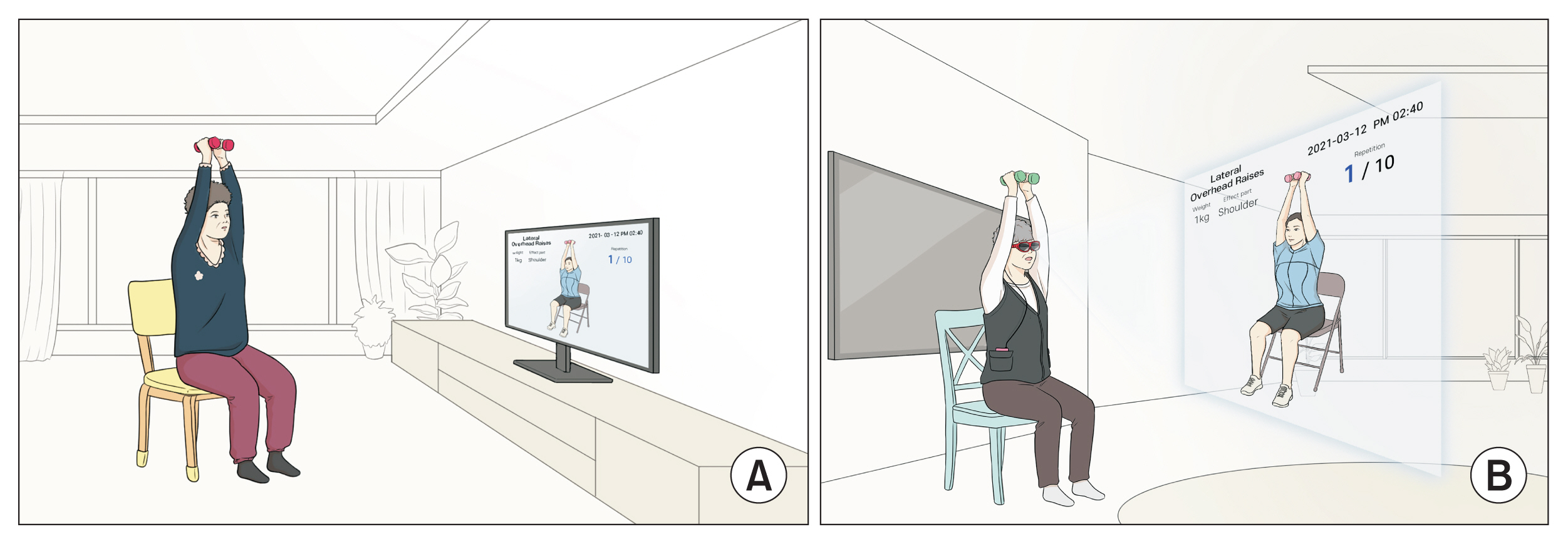Healthc Inform Res.
2023 Apr;29(2):161-167. 10.4258/hir.2023.29.2.161.
User Experience of Augmented Reality Glasses-based Tele-Exercise in Elderly Women
- Affiliations
-
- 1Medical Big Data Research Center, Seoul National University College of Medicine, Seoul, Korea
- 2Department of Transdisciplinary Medicine, Seoul National University Hospital, Seoul, Korea
- 3Department of Medicine, Seoul National University Hospital, Seoul, Korea
- 4Department of Plastic and Reconstructive Surgery, CHA Bundang Medical Center, CHA University School of Medicine, Seongnam, Korea
- 5Department of Surgery, Seoul National University College of Medicine, Seoul, Korea
- KMID: 2542142
- DOI: http://doi.org/10.4258/hir.2023.29.2.161
Abstract
Objectives
The purpose of this study was to identify any difference in user experience between tablet- and augmented reality (AR) glasses-based tele-exercise programs in elderly women.
Methods
Participants in the AR group (n = 14) connected Nreal glasses with smartphones to display a pre-recorded exercise program, while each member of the tablet group (n = 13) participated in the same exercise program using an all-in-one personal computer. The program included sitting or standing on a chair, bare-handed calisthenics, and muscle strengthening using an elastic band. The exercise movements were presented first for the upper and then the lower extremities, and the total exercise time was 40 minutes (5 minutes of warm-up exercises, 30 minutes of main exercises, and 5 minutes of cool-down exercises). To evaluate the user experience, a questionnaire consisting of a 7-point Likert scale was used as a measurement tool. In addition, the Wilcoxon rank-sum test was used to assess differences between the two groups.
Results
Of the six user experience scales, attractiveness (p = 0.114), stimulation (p = 0.534), and novelty (p = 0.916) did not differ significantly between the groups. However, efficiency (p = 0.006), perspicuity (p = 0.008), and dependability (p = 0.049) did vary significantly between groups.
Conclusions
When developing an AR glasses-based exercise program for the elderly, the efficiency, clarity, and stability of the program must be considered to meet the participants’ needs.
Figure
Reference
-
References
1. Olsson T, Karkkainen T, Lagerstam E, Venta-Olkkonen L. User evaluation of mobile augmented reality scenarios. J Ambient Intell Smart Environ. 2012; 4(1):29–47. https://doi.org/10.3233/AIS-2011-0127.
Article2. Van Krevelen DW, Poelman R. A survey of augmented reality technologies, applications and limitations. Int J Virtual Real. 2010; 9(2):1–20. https://doi.org/10.20870/IJVR.2010.9.2.2767.
Article3. Riley WT, Rivera DE, Atienza AA, Nilsen W, Allison SM, Mermelstein R. Health behavior models in the age of mobile interventions: are our theories up to the task? Transl Behav Med. 2011; 1(1):53–71. https://doi.org/10.1007/s13142-011-0021-7.
Article4. Payne HE, Lister C, West JH, Bernhardt JM. Behavioral functionality of mobile apps in health interventions: a systematic review of the literature. JMIR Mhealth Uhealth. 2015; 3(1):e20. https://doi.org/10.2196/mhealth.3335.
Article5. Merians AS, Jack D, Boian R, Tremaine M, Burdea GC, Adamovich SV, et al. Virtual reality-augmented rehabilitation for patients following stroke. Phys Ther. 2002; 82(9):898–915. https://doi.org/10.1093/ptj/82.9.898.
Article6. Kim U, Lee CS. A study on user-centered usability elements of user interface designs in an augmented reality environment. J Korea Inst Electron Commun Sci. 2018; 13(6):1317–22. https://doi.org/10.13067/JKIECS.2018.13.6.1317.
Article7. Lee J, Jung D, Byun J, Lee M. Effects of a combined exercise program using an iPad for older adults. Healthc Inform Res. 2016; 22(2):65–72. https://doi.org/10.4258/hir.2016.22.2.65.
Article8. Physical Activity Guidelines Advisory Committee. 2018 Physical Activity Guidelines Advisory Committee Scientific Report [Internet]. Washington (DC): U.S. Department of Health and Human Services;2018. [cited at 2023 Apr 22]. Available from: https://health.gov/sites/default/files/2019-09/PAG_Advisory_Committee_Report.pdf.9. Jeon S, Kim J. Effects of augmented-reality-based exercise on muscle parameters, physical performance, and exercise self-efficacy for older adults. Int J Environ Res Public Health. 2020; 17(9):3260. https://doi.org/10.3390/ijerph17093260.
Article10. Godtfredsen N, Frolich A, Bieler T, Beyer N, Kallemose T, Wilcke T, et al. 12-months follow-up of pulmonary tele-rehabilitation versus standard pulmonary rehabilitation: a multicentre randomised clinical trial in patients with severe COPD. Respir Med. 2020; 172:106129. https://doi.org/10.1016/j.rmed.2020.106129.
Article11. Hong J, Kim J, Kim SW, Kong HJ. Effects of home-based tele-exercise on sarcopenia among community-dwelling elderly adults: body composition and functional fitness. Exp Gerontol. 2017; 87(Pt A):33–9. https://doi.org/10.1016/j.exger.2016.11.002.
Article12. Gorman C, Gustafsson L. The use of augmented reality for rehabilitation after stroke: a narrative review. Disabil Rehabil Assist Technol. 2022; 17(4):409–17. https://doi.org/110.1080/17483107.2020.1791264.
Article13. Tunur T, DeBlois A, Yates-Horton E, Rickford K, Columna LA. Augmented reality-based dance intervention for individuals with Parkinson’s disease: a pilot study. Disabil Health J. 2020; 13(2):100848. https://doi.org/10.1016/j.dhjo.2019.100848.
Article14. Wikipedia. User experience [Internet]. [place unknown]: Wikipedia;2023. [cited at 2023 Apr 23]. Available from: https://en.wikipedia.org/wiki/User_experience.15. Laugwitz B, Held T, Schrepp M. Construction and evaluation of a user experience questionnaire. Holzinger A, editor. HCI and usability for education and work. Cham, Switzerland: Springer;2008. 63–76. https://doi.org/10.1007/978-3-540-89350-9_6.
Article16. International Organization for Standardization. Ergonomics of human-system interaction — Part 210: Human-centred design for interactive systems. Geneva, Switzerland: International Organization for Standardization;2019. 9241-210:2019.17. American College of Sports Medicine. ACSM’s guidelines for exercise testing and prescription. 10th ed. Philadelphia (PA): Lippincott Williams & Wilkins;2018.18. Borg GA. Psychophysical bases of perceived exertion. Med Sci Sports Exerc. 1982; 14(5):377–81. https://doi.org/10.1249/00005768-198205000-00012.
Article19. UEQ Team. User Experience Questionnaire [Internet]. [place unknown]: UEQ Team;2018. [cited at 2023 Apr 23]. Available from: https://www.ueq-online.org/.20. Schrepp M, Hinderks A, Thomaschewski J. Applying the user experience questionnaire (UEQ) in different evaluation scenarios. Marcus A, editor. Design, user experience, and usability: theories, methods, and tools for designing the user experience. Cham, Switzerland: Springer International Publishing;2014. 383–92. https://doi.org/10.1007/978-3-319-07668-3_37.
Article
- Full Text Links
- Actions
-
Cited
- CITED
-
- Close
- Share
- Similar articles
-
- Digital Therapeutic Exercises Using Augmented Reality Glasses for Frailty Prevention among Older Adults
- Augmented Reality in Medicine
- Virtual Reality and Augmented Reality in Plastic Surgery: A Review
- Effect of Augmented Reality Smart Glasses-based Nursing Skills Training for Nursing Students’ Medication Administration Safety Competency: A Quasi-experimental Study
- The effect of utilizing augmented reality in a mobile application for sequential tooth carving by users


